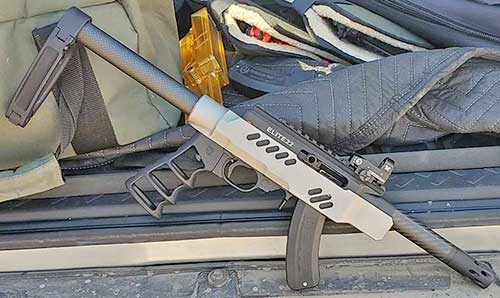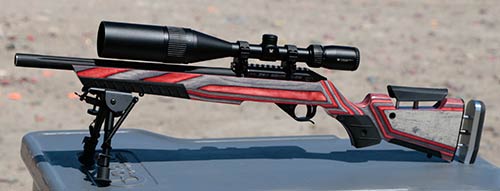Practical jokers and pranksters have April 1st, Star Wars geeks have May 4th, and fans of America’s favorite rimfire have 10/22. Yes, it’s the official day of the Ruger 10/22, Ruger’s top-selling rifle. Do we need a day devoted to this rifle? No, it gets plenty of love all year long. But that won’t stop me from sharing some facts about them, and a few of my favorites.
History of the Ruger 10/22
Designed way back in 1964, it’s been in continuous production since then. The profile is intended to mimic the M1 Carbine, but in a more wallet-friendly round. Even though centerfire ammo was affordable, it was still much less expensive to shoot the .22 rimfire round. A wood stock was standard back then, with a tapered barrel and simple iron sights. One of the keys to its success is the patented rotary ten-round magazine which made it compact (no magazine hanging down), and reliable. How successful? The Wikipedia entry that I stole some of my facts from (they’re not all made up) points out that 7 million were sold. As of 2015.
According to some advertisements, the MSRP back then was $54.50. That would be around $475 in today’s dollars. Yet Ruger has managed to leverage the economy of scale with lean manufacturing to keep prices down. When I bought my first one in 1987, they had gone up to $99. Last year, the most basic model with a plastic stock could still be found for as little as $189. Covid has wreaked havoc on pricing, but they can still be found on sale for around $229, making them something of a bargain.
[Here’s where I would share a photo of a totally stock Ruger 10/22, if I had a totally stock Ruger 10/22]
Variants
In addition to the standard .22 caliber 10/22, they have been some other calibers available. Between 1998 and 2006, Ruger offered the 10/22 Magnum. Obviously, it was chambered in .22 WMR. Likewise, there was a 10/17 offered from around 2004 to 2006. This was chambered in .17 HMR. Apparently, no one liked that, as it disappeared quickly and quietly. Neither were ideal rounds for a semi-auto though, so don’t blame Ruger.
Ruger wasn’t content with the basic 10/22 Carbine model either. So we’ve seen a Target, Target Lite, a Compact, Sporter, Competition, and even a Tactical. Yes, a “tactical” rimfire. On top of that, there have been plenty of special editions. While the basic format never changed, the barrel profiles did, as well as the stock designs and materials. In 2012, Ruger finally cut a stock in half, and offered the Takedown model. Well, there was a change in the barrel fitment, and a locking mechanism too. But the Takedown took off, and is still a popular option today.

The 22 Charger
Ruger’s 22 Charger is a 10/22 variant by design, but without the 10/22 designation, for legal reasons. The rifle itself is known as the 10/22 in the patent and trademark documentation. When Ruger released the 22 Charger at the end of 2007, they couldn’t call it a “10/22 Charger”, as this is the pistol configuration. So it’s simply the 22 Charger. Same receiver (sans the “10/22” marking), same bolt, magazines, and trigger group. The difference was the barrel and stock, both of which were shorter. It’s hard to believe, but they discontinued it for a while, and then it returned late 2014. Today, it’s one of the hottest sellers, due to the ability to add a brace and suppressor. I’m not showing a stock one, because hardly anyone keeps theirs stock.

Aftermarket support
As mentioned, few people keep their 10/22 as original as when it left the factory. Its bolt release requires three hands to use, and that is one of the first things to be replaced or modified with a file. Sights get upgraded, and the magazine release too. Then maybe a trigger. And the barrel, which might require a new stock. Although it’s certainly possible to build a “10/22″ using zero factory Ruger parts, that’s not always the best way. Many have discovered the fun in buying a stock rifle, and replacing all the parts over time, so they have two rifles. And then they start the cycle again.
Plenty of companies make aftermarket receivers, which have better finish and tighter tolerances than OEM. Barrels are available in steel, or steel with a sleeve of aluminum or carbon fiber, for lighter weight while still being rigid. Common profiles include the factory taper up to fat .920” “bull barrels”. Stocks are wood, laminate, polymers, and there are plenty of aluminum chassis options too. Ruger offers their own BX trigger upgrade, or it’s easy to drop up to around $300 on an aftermarket unit. All the other parts are available as well, and everything can be had in nearly any color of the rainbow. If you want to go crazy, just get out your credit card. The rifle pictured below is comprised of 100% aftermarket parts. Read about it here.

Why the 10/22 is important
For many shooting enthusiasts, the Ruger 10/22 was or is their first firearm. Or it was their introduction to firearms. Check online, and you’ll frequently read about someone inheriting one, or buying one “like dad had”. It was my first rifle, and my first firearm. And I have taught plenty of my friends, and their kids, how to shoot using one. Relatively low cost, reasonably priced ammo, near zero recoil, and with a suppressor, very hearing-friendly. They are a gateway gun into the sport of recreational shooting. A staple of Appleseed events. A great way to learn gun safety and basic marksmanship. Ruger’s 10/22 should be celebrated for those reasons, if nothing else. But the truth is, they’re just a ton of fun. If you don’t have one, find someone who does, and it will all become clear. Every enthusiast should have one at least once in their life.
